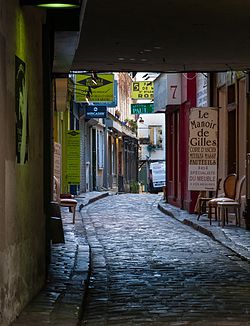Faubourg Saint-Antoine
Faubourg Saint-Antoine | |
|---|---|
Faubourg | |
 Passage du Chantier | |
 Vaugondy's map of Paris (Faubourg Saint-Antoine) - 1760 | |
| Country | France |
| City | Paris |
| Arrondissement | 12th |
The Faubourg Saint-Antoine was one of the traditional suburbs of Paris, France. It grew up to the east of the Bastille around the abbey of Saint-Antoine-des-Champs, and ran along the Rue du Faubourg Saint-Antoine.
Location
The Faubourg Saint-Antoine extended from the Porte Saint-Antoine towards the abbey of Saint-Antoine-des-Champs, then to the Château de Vincennes. Roads led to the villages of Charenton, Charonne, Reuilly and Montreuil, which provided large amounts of wine, fruit and vegetables to the city.[1] Today the former faubourg is divided by the rue du Faubourg Saint-Antoine between the 11th arrondissement of Paris, which extends to the north of the road, and 12th arrondissement, which extends to the south.
History
The suburb was the location of the Battle of the Faubourg St Antoine on 2 July 1652.
In the 17th century, according to Piganiol de La Force, "The Faubourg Saint-Antoine increased prodigiously from the large number of houses that were built there, both because of the good air and because of the king's letters patent of 1657, which exempted from the qualification of mastership all artisans and tradespeople who lived there." Firewood and construction timber from higher up the Seine was unloaded at the nearby Quai de la Rapée on the Île Louviers and stored in the faubourg, leading to development of woodworking crafts.[1]
During the French Revolution (1789-99) the faubourg was given the name "Faubourg-de-Gloire".[2] The faubourg gained a reputation for turbulence during the revolution, starting with the storming of the Bastille on 14 July 1789. The people of the Quinze-Vingts and Montreuil sections took part in the insurrection of 10 August 1792, and that of 2 June 1793 that caused to Girondins to fall from power. The revolt of 1 Prairial Year III began in the faubourg, and was savagely repressed.[1]
-
Porte St-Antoine c. 1550
-
Battle of the Faubourg St Antoine by the Walls of the Bastille
Notes
- ^ a b c Hazan 2011, p. 122.
- ^ Figuères 1901, p. 62.
Sources
- Figuères, Roger de (1901), Les noms révolutionnaires des communes de France ; listes par départements et liste générale alphabétique (in French), Paris: Société de l'histoire de la révolution française, retrieved 2016-01-03
- Hazan, Eric (2011-05-23), The Invention of Paris: A History in Footsteps, Verso Books, ISBN 978-1-84467-800-6, retrieved 2016-01-03


